What: Ekphrastic!, the third reading
Where: Krowswork Gallery, 480 23rd St., Oakland, CA
When: Saturday March 12, 7:30 – 10:30 p.m.
Who: ‘Lectric Collective (Jillian Roberts, Sarah Rothberg, Kelsa Trom) presents
Poets: Steven Lance, John Sakkis, C.S. Giscombe
Exhibiting Artists: Anthony Dubovsky, Shannon May, Jae Lauren Payne, Jon Stich, Ben Belknap, Peter Schulte, Misako Inaoka, Sarah Ratchye
Review written by Jared Alford, Omnidawn’s Facebook Editor and Lit Scene Features Reviewer.
This third show of the “Ekphrastic!” series presents an ensemble of paintings and poems generated through conversations between artists and writers, with the paintings serving as visual translations of the poets’ words, thus inversing the usual order understood by ekphrasis (from the Greek, “ek” and “phrasis,” “out” and “speak”), in which the visual artwork serves as the source for a graphic, often dramatic description.
The night begins at 7:30, and from then until 8:00 or later light chatter and easy gazes fill the brightly lit room to the left of the entrance, while some prepare to listen in the dark room to the right. In this left room, there are seven visual works and one audio, each based on a different poem to be read aloud.
The first poet, Steven Lance, a recent graduate of UC Berkeley, reads five poems which might be said, as one host indicated, to exhibit a fluent synthesis of logic, history, and poetry—or, even grander, a veritable symphony played by none other than Time and Reason on the black-and-whites of the text. As exemplified in the poem included below, “Letatlin,” the poems often combine the cinematic, monumental, and referential into whimsical narratives of subtle characters, wonder, and humor—deftly delivered in the poet’s careful, gentle tones. One of his collaborators, Misako Inaoka, contributes perhaps the most singular visual piece of the event, echoing this rare knack for hybridizing the improbable with a metal sculpture sprightly thrusting its wondrous body of butterfly, luxurious balconies, and what look to be cocoons. Sarah Ratchye also presents visual re-combinations with “Things and WhAr BEtwEen,” and “Th’ unsrtAntE uv antlrz,” the first a graphite work of gradations of scribble in the shapes of lips, flowers, and orbs, and the second a collage again presenting lips and ornamental orbs, but this time with cherries, buttons, and a curious bird which seems part hummingbird, part eagle.
Next appears John Sakkis, who reads fairly lengthy poems of such rhythm and reference sliding in and out of the satirical their brisk tones edge toward the brusque, but remain sincere. In the selection included below, for example, in “The Lone Gunmen,” we are circulated “From Simon Magus to Moses to Logos,” and confronted by “the Gunmen… named after an Airforce base / A punk rock band and JFK,” so that by the end of it we feel perhaps “like ghosts asking stupidly / ‘Where does [such] lightning come from… / By what will…?,” left in wonder by our “Magician incarnate,” John Sakkis. His poems are refigured by Jon Stich, who contributes some pen-work figuring Chewbacca in cross-hatch poised to destroy a Muni bus, as well as by Shannon May, who presents hypnotic amalgamations of black-and white orbs, dark wisps, perhaps a vague face, and hands or paw-tracks.
Finally comes C.S. Giscombe, a professor in UC Berkeley’s English department, who commits constellations of cities and genealogies of travelers to lucid lines of keen reflections and nuanced descriptions. A selection from Giscome Road is translated into the single audio piece in the event, “The Bridge,” by Peter Schulte, a mostly gently mesmerizing work of over 13 minutes filled with crackling electronic oscillations, organ and trumpet tones, what sounds like coyotes and ocean waves, and a brief plateau of heavy drones and calls for “Home” approaching the 10-minute mark. Jae Lauren Payne also contributes with “Popcorn Tin,” consisting of what looks to be a 4”x4” canvas embedded in old red brick featuring stark, rippling textures and three-dimensional elements of wood and construction materials in shades of white and aqueous blue and green.
The Ekphrasis! series continues with its fourth iteration sometime in mid-May, when the ‘Lectric Collective curates a similar assemblage of larger scale, gathering together curators of reading series with curators of art galleries, with artists responding to writers’ work once again. Writers that have so far expressed their interest include David Brazil, Sarah Larsen, Sara Mumolo, Brandon Brown, Brent Cunningham, Jackqueline Frost, and Zack Tuck.
Stay tuned to lectriccollective.blogspot.com for updates.
“Letatlin”
Steven Lance
At the end of the movie
it took on the shape of a bird
and so did the camera, we flew
to a house where an old man
kept several black cats.
The monument would not be built because it had been pronounced
structurally unsound. In these poems the words are often composed
figuratively to form a picture. Other words make a fig tree,
the winged fig tree in the Louvre representing the genre.
The coats were also cats, which I think was the joke. The pictures make a poem
and dominate the staircase. Its right hand raise in epiphanic salute
was discovered years later but could not be attached.
Returning from the city they surprised themselves
with a new sophistication, a joke about old men and cats.
He would tell it in the voice of Sir Walter Scott, he would
tell it only his eldest son. Vladimir Tatlin
waved from the glass revolving cylinder
down to the crow, all Petrograd watching in wonder.
There are phrases for what this was. There are phrases for fig trees
and phrases for “the first October object.”
He built a flying machine with wings like Leonardo’s
and he strapped himself beneath it for a group of reporters.
They took his picture but so much had changed,
it was 1932, and there was something pathetic in his
boy’s smile and his boy’s dream of wings.
*
“The Lone Gunmen”
John Sakkis
Hubba hubba in the West
But it’s his magical powers
That keeps that magazine in circulation
From Simon Magus to Moses to Logos
A judge with his own store
But it’s where we hideout
And just as Scully was named after
A baseball announcer, The Gunmen
Are named after an Airforce base
A punk rock band and JFK
The History Of Hell in a series spinoff
And that little cry-baby CC
Was anything but a duelist
Dropping the hammer on message boards
Swearing to kill off anybody not
Tuned into this Friday night ménage
Until Mulder was tasked to chat
With these ghosts asking stupidly
“Where does lightening come from, and
By what will does it strike the tower?”
In this theogony TLG might be
The Bride but your ideas are even
Weirder than the myriad scientific
Inaccuracies of the sci-fi series Earth 2
El Lobo appears to live a normal life
And his motto “as above, so below”
Might trick a satellite dish into bouncing
Back his image, but don’t be fooled
By these childish scraps, he is the
Magician incarnate asking for assistance
*
TWO DIRECTIONS
C.S. Giscombe
To me love’s an animal, not the feeling of watching one but the animal itself—blunt, active, equipped. The long body and, almost independent of that, the mobile head, the range of its movement, the obvious ambivalence. A horse in the river.
I was a sad boy in a dream on his bicycle in the marshes. Always the first question is Where? Jamaica probably along the Black River itself where the boat takes one to see the crocodiles and then there’s a place to eat at the end of the tour where the tour boat turns around at a low bridge. A dream of what?
Love’s an animal to me, not working one or the expectation of one’s arrival, not “love’s animal.” Love’s full of uncorrected error, the fact of it being unseen or seen and stared at, speechless beneath a bridge, eating with its mouth instead, a croc or any animal.
An island, a river, a bridge. Marshes in the dream, though bird-less; and a swaying wooden bridge and the image of a missile having gone up or come up—from where?—through it: I offered it to the boy bicycling as a kind of humorous solace for his situation, an aimless if tangential exaggeration.
(But at the end was a small train station—an archetype—, just out of town, out of the marsh, and going there I got, in the dream, to long strands of passenger cars stretching out in two directions, platforms alongside.)

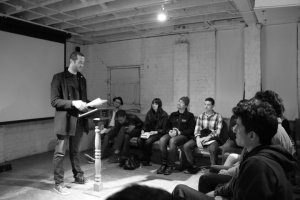
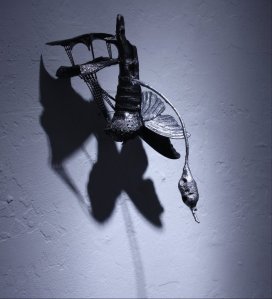
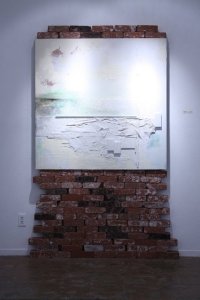
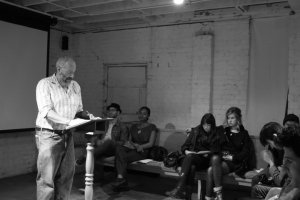
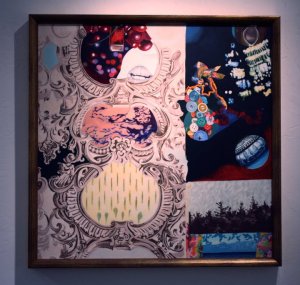

No comments:
Post a Comment